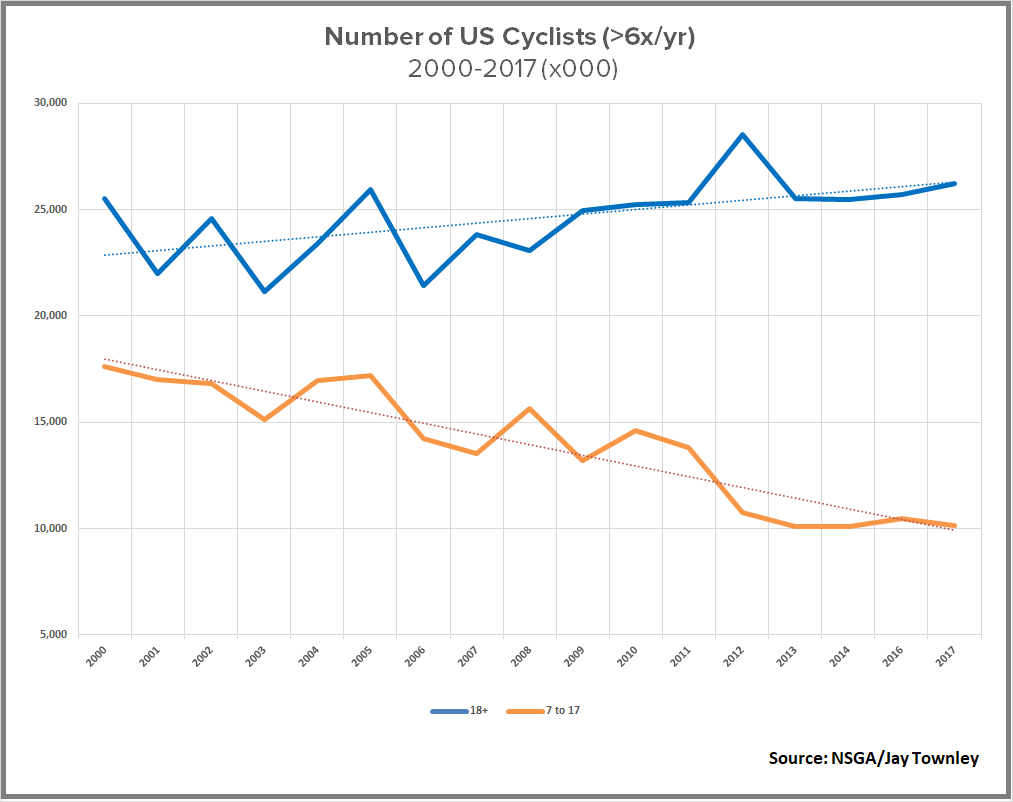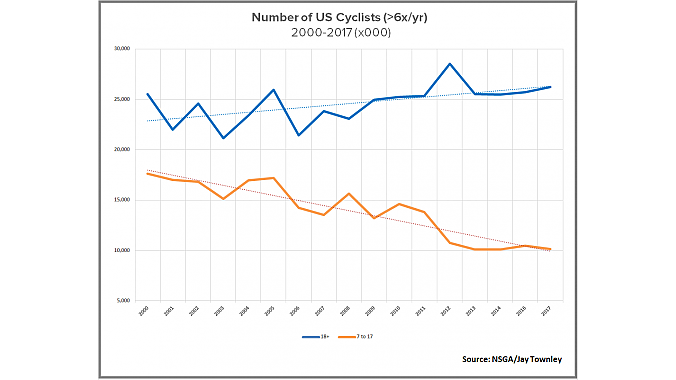By Rick Vosper
Let's look at the numbers
The National Sporting Goods Association (NSGA) defines frequent cyclists as people aged 7 and up taking six or more rides per year. The NSGA data shows those numbers dropped 17 percent between 2000 and 2017, a loss of 6.8 million cyclists. But it gets worse.
 Here's a chart I've used before, updated through 2017. While active adult cyclists (blue line) have held more or less steady since 2000 (in fact, 2017 shows an encouraging net increase of not quite 7 percent versus the 18-year average), the number of kids riding bikes six or more times per year (orange line) has dropped more than 40 percent. On a per capita basis, the percentage of kids lost grows to more than half.
Here's a chart I've used before, updated through 2017. While active adult cyclists (blue line) have held more or less steady since 2000 (in fact, 2017 shows an encouraging net increase of not quite 7 percent versus the 18-year average), the number of kids riding bikes six or more times per year (orange line) has dropped more than 40 percent. On a per capita basis, the percentage of kids lost grows to more than half.
While we gained 700,000 adult cyclists since 2000, in the same time we've lost 7.5 million children and teens. And all this while the number of obese kids in the U.S. has quadrupled since the 1970s, with a 25 percent increase since 2000 alone.
Do you detect a trend here? Me too. Of course correlation is not causality, but the conclusion seems inescapable that fewer kids riding bikes equals more kids getting fat.
But that also means more kids riding bikes can mean fewer kids getting fat.
So here's the windup ...
That sound you hear is opportunity knocking — perhaps even pounding — at our door.
The Centers for Disease Control and Prevention estimates there are currently 13.7 million obese kids in the United States. I think it's a fair bet many of their parents want them leaner and healthier and aren't entirely sure how to go about it. So we have a potential source of customers.
At the same time, the industry already has products in place to appeal to those parents. Every large and medium-size bike brand offers a range of IBD-quality kids bicycles at different price points — not to mention the growing number of kid-specific bike companies with excellent offerings. So we have a source of products to sell to those customers.
We have a generation of retailers increasingly turning to family-oriented bike sales as a major revenue source. There are even more who'd be happy to get into that segment if families started showing up in their stores on a sunny Saturday morning with credit cards at the ready. So we have an established sales channel to reach customers who will want to buy our products.
We also have a relatively new wave of PR/advertising companies with cycling backgrounds. Companies like SOAR, Hanson Dodge, True Communications and others. These are smart people who came up in the cycling and outdoor sporting businesses who truly understand our value proposition and who can take our case to mainstream American media. So we have a source of experienced marketers to help us sell both those products and the concept behind them. More about them in a minute.
Finally, we have something we didn't have 10 or even five years ago: a strong and growing network of support programs dedicated to getting kids on bikes for exercise, fun and transportation — groups like NICA, Trips for Kids and Safe Routes to School. We also have an increasing number of bike paths and bike routes for them to ride on. So we have a developing infrastructure for consumers to use the products we sell.
Put these elements together and we can effectively position bikes as the cure for childhood obesity.
... and the pitch
We need a dual strategy.
The first part is the obvious message that cycling to school or with friends or family is fun and helps produce fit kids. Less obvious but just as important is that it's also safe. Safe Routes to School knows safe routes to school (duh) and how to keep kids safe on those routes. Trips For Kids creates safe trips for kids. NICA creates a safe and fun racing environment for older, more competitive kids.
The second part is to move the perception of kids bikes away from being toys and toward being recreational/fitness equipment. Which is to say specialty retail-level equipment. You want to help your kid slim down, you need to make a (reasonably modest) investment.
How we're going to do that: building a new generation of riders
That's where the PR companies come in. These professionals can get spokespeople from the cycling industry onto morning television and radio shows and into wide-circulation magazines. They can get pictures of celebrities and their children riding bikes together onto the web and social media. They can get product placements in movies. And this PR will help get kids riding to and from school, kids riding with friends, and even better, kids riding with their parents who will drive an incremental increase in adult bike purchases.
Even better, PR can accomplish all this for a fraction of the cost of "Got Milk?"-style advertising.
So who's picking up the check?
It's time for the industry to collectively recognize that 20 years of infrastructure-building masquerading as advocacy has literally done less than nothing to increase total ridership. In fact we've lost 7.2 million young riders who soon enough will turn into 7.2 million fewer adult riders.
If nothing else, that's very bad for business and for existing cycling culture. We need to build a new generation of riders. And as an industry, we need to build a new generation of customers.
Meanwhile we have more and more infrastructure accommodating fewer and fewer riders. The millions of dollars in federal and other grants PeopleForBikes currently administers are virtually all earmarked for infrastructure projects like bike lanes and bike paths. So funding to get more kids on (more) bikes more often — which is allegedly PFB's mission, after all — and onto those lanes and paths will have to come from other sources. Three of these might include industry companies currently writing checks for paint and path semi-solutions, parents of the kids benefiting from bike-based anti-obesity programs, and our existing rider base of more than 35 million frequent adult cyclists who see the benefits both for bike culture and for their own families.
It's a big win for obese kids and their parents, a big win for existing cyclists, a big win for infrastructuralists (more people riding on the infrastructure means more infrastructure funding) and a big win for the industry.
And not incidentally, it's a big win for those of us who would like to see cyclists and cycling become heroes in the eyes of the American public.





